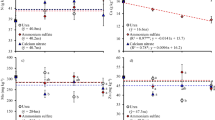Summary
Spraying a young cereal crop with the herbicide DNOC enhances yield apart from its weed-eliminating action. This study examined the extent to which this increase is due to the nitrogen-fertilizing effect of the spray. To this end the effects of a spray on growth, nitrogen uptake and yield of winter rye were examined at four nitrogen levels in two field experiments.
Analogous in many respects to nitrogen fertilizing, the DNOC spray stimulated vegetative growth and the production of photosynthesizing area, retarded chlorophyll breakdown at ripening and increased yield by improving both the number of ears and number of grains per ear. It differed, however, in that growth stimulations was preceded by a temporary retardation and also in that the other positive effects were generally strongest not under conditions of nitrogen deficiency but when DNOC was applied together with nitrogen. The thousand-kernel weight was affected in opposite directions by the two treatments. The extra amounts of nitrogen taken up by the DNOC-treated plants could not account for the magnitude of the effects of the spray.
It is argued that the DNOC spray, rather than replacing nitrogen, promotes a better use of it by inducing stronger growth of the root system and a prolongation of the vegetation period. This involves both a larger uptake of nitrogen from the soil and a better distribution of it in the plant.
Similar content being viewed by others
References
Borodin, I., The influence of nitrogenous and mineral nutrition on the time of heading in barley and millet under the conditions of different day length. Bull. Appl. Botany Genet. Plant Breeding Leningrad27, 171–195 (1931).
Bruinsma, J., The action of 4,6-dinitro-o-cresol (DNOC) in soil. I. The emergence from cress seed in DNOC-treated soil mixtures. Plant and Soil12, 249–258 (1960).
Bruinsma, J., The effect of pesticides on the chlorophyll content of leaves and stalks. Mededel. Landbouwhogeschool Gent26, 1513–1522 (1961).
Bruinsma, J., The effect of a spray with 4,6-dinitro-o-cresol (DNOC) on growth, development and yield of winter rye (Secale cereale L.). Weed Research2, 73–89 (1962).
Coïc, Y., Recherches sur le meilleur équilibre entre densité de plantes et fertilisation azotée du blé d'hiver. Ann. Physiol. Végétale1, 53–58 (1959).
Dennfer, D. von, Blühhormon oder Blühhemmung? Neue Gesichtspunkte zur Physiologie der Blütenbildung. Naturwiss.37, 296–301, 317–321 (1950).
Dobben, W. H. van, The influence of spraying with DNOC on the growth of winter rye. Verslag C.I.L.O. (Wageningen)1955, 133–141 (1956).
Dobben, W. H. van, Unpublished data.
Eichinger. Die Beeinflussung der Länge der Winterroggenähren und der Zahl der Aehrchen durch Düngung und Aussaatzeit. Eine Methode zur Unterscheidung von Winter- und Sommersaatgut. Angew. Botan.10, 66–79 (1928).
Gott, M. B., Gregory, F. G., and Purvis, O. N., Studies in vernalisation of cereals. 13. Photoperiodic control of stages in flowering between initiation and ear formation in vernalised and unvernalised Petkus Winter rye. Ann. Botany N.S.19, 87–126 (1955).
Hänsel, H., Vernalisation of winter rye by negative temperatures and the influence of vernalisation upon the lamina leaf length of the first and second leaf in winter rye, spring barley and winterbarley. Ann. Botany N.S.17, 417–432 (1953).
Jensen, H. L. and Petersen, H. I., Decomposition of hormone herbicides by bacteria. Acta Agr. Scand.2, 215–231 (1952).
Khalil, M. S. H., The interrelation between growth and development of wheat as influenced by temperature, light and nitrogen. Mededel. Landbouwhogeschool Wageningen56, (7), 1–73 (1956).
Pollmer, G., Untersuchungen zur Ertragsbildung bei Sommerweizen. Z. Pflanzenzüchtung37, 231–262 (1957).
Purvis, O. N., An analysis of the influence of temperature during germination on the subsequent development of certain winter cereals and its relation to the effect of length of day. Ann. Botany48, 919–955 (1934).
Riepma, P. Kzn., The importance of DNOC for the grain crops in the Netherlands. Landbouwk. Tijdschr.65, 334–338 (1953).
Riepma, P. Kzn., The reaction of cereals and pulse crops on dinitro's. Mededel. Landbouwhogeschool Gent19, 451–456 (1954).
Sande Bakhuijzen, H. L. van de, Basic principles in the growth of wheat and other agricultural plants. Landbouwk. Tijdschr.49, 885–900 (1937).
Bruinsma, J. and Swart, J., The development of the rye spike until emergence. Acta Botan, Neerl.11, 411–417 (1962).
Author information
Authors and Affiliations
Rights and permissions
About this article
Cite this article
Bruinsma, J. The effect of a spray with 4,6-dinitro-o-cresol (DNOC) on nitrogen nutrition and yield of winter rye (Secale Cereale L.). Plant Soil 18, 1–20 (1963). https://doi.org/10.1007/BF01391676
Received:
Issue Date:
DOI: https://doi.org/10.1007/BF01391676



